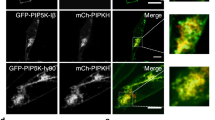Abstract
SWAP-70 is a phosphatidylinositol trisphosphate (PtdIns(3,4,5)P3)-binding protein, which is suggested to be involved in membrane ruffling, cooperating with activated Rac. Various point mutations were introduced in the PH domain. Substitutions of alanines for the positively charged amino acids within the first loop abolished the binding activity of the PH domains to PtdIns(3,4,5)P3. The PtdIns(3,4,5)P3 binding activity was required for translocation of SWAP-70 to the membrane, enhancement of membrane ruffling by the overexpressed protein, or the dominant-negative effect of a mutant lacking the carboxyl terminal region in membrane ruffling. When Rac was overexpressed, the above mutants were translocated to the membrane and exhibited a dominant-negative effect on membrane ruffling without PtdIns(3,4,5)P3-binding activity. These results suggest that the PtdIns(3,4,5)P3-binding activity is dispensable for these events when SWAP-70 and Rac interacts efficiently. These results implicate that binding of SWAP-70 to PtdIns(3,4,5)P3 may facilitate the recruitment of SWAP-70 to activated Rac.
Similar content being viewed by others
References
Borggrefe T, Wabl M, Akhmedov AT, Jessberger R: A B-cell-specific DNA recombinationcomplex. J Biol Chem 273: 17025–17035, 1998
Borggrefe T, Keshavarzi S, Gross B, Wabl M, Jessberger R: Impaired IgE response inSWAP-70-deficient mice. Eur J Immunol 31: 2467–2475, 2001
Masat L, Caldwell J, Armstrong R, Khoshnevisan H, Jessberger R, Herndier B, Wabl M, Ferrick D: Association of SWAP-70 with the B cell antigen receptor complex. Proc Natl AcadSci U S A 97: 2180–2184, 2000
Shinohara M, Terada Y, Iwamatsu A, Shinohara A, Mochizuki N, Higuchi M, Gotoh Y, Ihara S, Nagata S, Itoh H, Fukui Y, Jessberger R: SWAP-70 is a guanine-nucleotide-exchange factorthat mediates signalling of membrane ruffling. Nature 416: 759–763, 2002
Ihara S, Oka T, Fukui Y: Direct binding of SWAP-70 to non-muscle actin is required formembrane ruffling. J Cell Sci 119: 500–507, 2006
Musacchio A, Gibson T, Rice P, Thompson J, Saraste M: The PH domain: a common piece in thestructural patchwork of signalling proteins. Trends Biochem Sci 18: 343–348, 1993
Mayer BJ, Ren R, Clark KL, Baltimore D: A putative modular domain present in diversesignaling proteins. Cell 73: 629–630, 1993
Haslam RJ, Koide HB, Hemmings BA: Pleckstrin domain homology. Nature 363: 309–310, 1993
Fushman D, Najmabadi-Haske T, Cahill S, Zheng J, LeVine H, 3rd, Cowburn D: The solutionstructure and dynamics of the pleckstrin homology domain of G protein-coupled receptorkinase 2 (β-adrenergic receptor kinase 1). A binding partner of Gβγ subunits. J Biol Chem 273: 2835–2843, 1998
Lemmon MA, Ferguson KM: Signal-dependent membrane targeting by pleckstrin homology (PH)domains. Biochem J 350(1): 1–18, 2000
Isakoff SJ, Cardozo T, Andreev J, Li Z, Ferguson KM, Abagyan R, Lemmon MA, Aronheim A, Skolnik EY: Identification and analysis of PH domain-containing targets ofphosphatidylinositol 3-kinase using a novel in vivo assay in yeast. EMBO J 17: 5374–5387,1998
Ferguson KM, Kavran JM, Sankaran VG, Fournier E, Isakoff SJ, Skolnik EY, Lemmon MA:Structural basis for discrimination of 3-phosphoinositides by pleckstrin homology domains. Mol Cell 6: 373–384, 2000
Kojima T, Fukuda M, Watanabe Y, Hamazato F, Mikoshiba K: Characterization of thepleckstrin homology domain of Btk as an inositol polyphosphate and phosphoinositidebinding domain. Biochem Biophys Res Commun 236: 333–339, 1997
van der Geer P, Wiley S, Gish GD, Pawson T: The Shc adaptor protein is highlyphosphorylated at conserved, twin tyrosine residues (Y239/240) that mediateprotein-protein interactions. Curr Biol 6: 1435–1444, 1996
Mizushima S, Nagata S: pEF-BOS, a powerful mammalian expression vector. Nucleic Acids Res18: 5322, 1990
Sawano A, Miyawaki A: Directed evolution of green fluorescent protein by a new versatilePCR strategy for site-directed and semi-random mutagenesis. Nucleic Acids Res 28: E78, 2000
Shirai T, Tanaka K, Terada Y, Sawada T, Shirai R, Hashimoto Y, Nagata S, Iwamatsu A, OkawaK, Li S, Hattori S, Mano H, Fukui Y: Specific detection of phosphatidylinositol3,4,5-trisphosphate binding proteins by the PIP3 analogue beads: an application for rapidpurification of the PIP3 binding proteins. Biochim Biophys Acta 1402: 292–302, 1998
Laemmli UK: Cleavage of structural proteins during the assembly of the head ofbacteriophage T4. Nature 227: 680–685, 1970
Tanaka K, Horiguchi K, Yoshida T, Takeda M, Fujisawa H, Takeuchi K, Umeda M, Kato S, IharaS, Nagata S, Fukui Y: Evidence that a phosphatidylinositol 3,4,5-trisphosphate-bindingprotein can function in nucleus. J Biol Chem 274: 3919–3922, 1999
Wells CM, Walmsley M, Ooi S, Tybulewicz V, Ridley AJ: Rac1-deficient macrophages exhibitdefects in cell spreading and membrane ruffling but not migration. J Cell Sci 117:1259–1268, 2004
Author information
Authors and Affiliations
Corresponding author
Rights and permissions
About this article
Cite this article
Wakamatsu, I., Ihara, S. & Fukui, Y. Mutational analysis on the function of the SWAP-70 PH domain. Mol Cell Biochem 293, 137–145 (2006). https://doi.org/10.1007/s11010-006-9236-1
Received:
Accepted:
Published:
Issue Date:
DOI: https://doi.org/10.1007/s11010-006-9236-1




